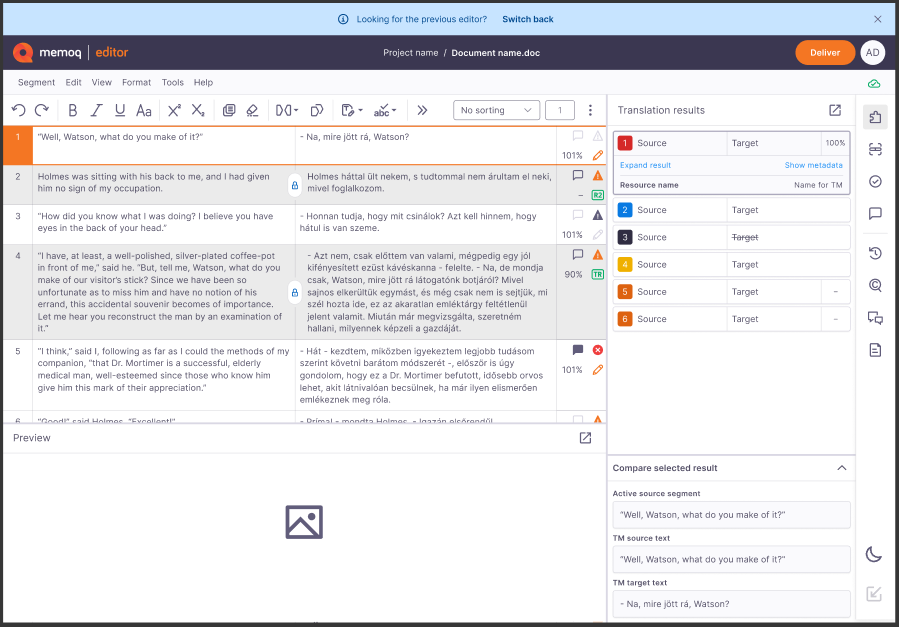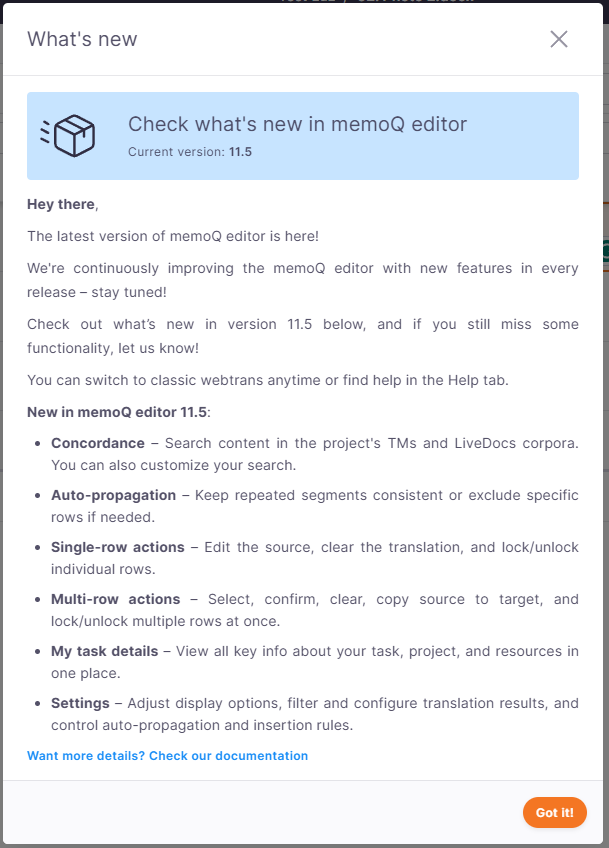memoQ editor
memoQ editor is part of memoQ TMS, which means it’s available only to organizations with a memoQ TMS subscription.
This is our fresh take on the classic webtrans - the tool where you can write, edit, or review your translation in a browser.
Who can use memoQ editor?
-
Companies: Can use it with an active memoQ TMS subscription. They handle the licensing.
-
In-house translators: Can use it with a web license provided by their company.
-
Freelance translators: Can access memoQ editor via a web license assigned by a client for specific projects. Unfortunately, they can’t buy memoQ editor for personal use.

How to get here
-
Log in to memoQweb as a project manager.
-
In the Active projects list, click the project you want to work on.
-
Then, click the document's name.
It opens in a separate browser tab, in the new memoQ editor.
First time in memoQ editor?
When you open a translation document for the first time after an update to memoQ 11.5 or later, you’ll see a What's new window. It highlights the latest features, so you can quickly see what’s changed and start using the improvements right away.

If you need more details about the latest features, click Check our documentation.
To open this window anytime, in the top menu, click Help, then choose What's new.
You can switch between the new memoQ editor and the classic webtrans interface at any time, depending on your workflow and feature requirements.
How to switch back to webtrans?
-
Click Switch back on the banner at the top of the page.
-
If the banner is no longer visible, click Help in the top menu and select Switch back to the previous editor.
What happens when you switch?
-
Once you switch, you'll be able to continue working in the classic webtrans.
-
If you want to return to the new memoQ editor later, use the Try the new editor button in the header. You can switch between the two editors at any time.
-
When a new version of the memoQ editor is released, you’ll see the What's new screen. You can still switch back if the new version doesn’t yet have all the features you need.
Your feedback is crucial in shaping the new memoQ editor. If you switch back, let us know what’s missing so we can improve the tool and your experience.
What can you do?
As a linguist:
-
Translate or review your documents in the translation grid.
-
Use the Translation results pane to check suggestions from translation memories, LiveDocs, and machine translation. You can insert or review them as needed.
-
Pre-translate your content to fill in segments automatically using resources configured in your project. Try using machine translation when no TM or LiveDocs matches are found, decide how to handle unmatched segments or tag errors, and optionally apply TM-driven segmentation to improve match accuracy.
-
See how the document looks in the Preview pane.
-
 Check details of your current task
Check details of your current task
When you start working on a document you've been assigned to, memoQ editor displays the My task details window to help you understand everything about your task at a glance.
This window opens automatically the first time you open a document. You can also access it any time via the Help menu (only if you're assigned to the task).
Project managers or admins who aren't assigned to the document won’t see this window or menu item.
What’s inside the My task details window?

-
Task info: Project and document name, your role (e.g., Translator, Reviewer 1), deadline, language pair (source → target).
-
Project info: Project, client, subject, domain, and description.
-
Task rules: This section shows what you're allowed to do in this document. You can see here rules set by the PM, e.g., can translators and reviewers work at the same time? Yes/No, can you join/split segments? Yes/No.
-
Under Project resources you can find info about resources attached to your project.
-
-
 Tailor your workspace with editor settings
Tailor your workspace with editor settings
You can customize memoQ editor in the Settings window.
To do that:
-
In the top menu, click Tools.
-
From the dropdown, select Settings to open the Settings window.
The Settings window is organized into three expandable sections that allows you to:
Each accordion has a Reset to default button to restore its settings independently.
When you first open the Settings dialog, all accordions are closed to reduce clutter. You can open multiple accordions simultaneously, and your preferences will be remembered next time.
-
-
 Check your tasks and profile
Check your tasks and profile
You can check all the translations tasks assigned to you on the My tasks page.
To get there, click the icon with your initials in the top-right corner of the screen.
memoQ editor redirects you to the My tasks page in memoQweb.
From here, you can also go to your profile in memoQweb, check your role, or log out.
-
 Use shortcuts for faster work
Use shortcuts for faster work
As a project manager:
-
 Lock and unlock segments
Lock and unlock segments
If you are a project manager or an admin, you can lock rows to prevent translators or reviewers from editing them.
To do that, in the top menu click the Segment tab, and then from the dropdown list choose Lock/unlock segment.
You can also press Ctrl+Shift+L.
Locked rows show a lock icon and are excluded from editing. Unlocking removes the lock icon and allows editing. It's possible to lock or unlock multiple segments at once.
-
 Allow linguists to export documents
Allow linguists to export documents
As a project manager you can allow linguists to export documents. To do that:
- Log in to memoQweb as an administrator or a project manager.
- On the Active projects list, click a project.
- At the top of the screen, click the Settings tab.
- On the Settings page, click the Options tile.
- Under the Document options section, choose the Allow users to export translated document option.
Linguists can see this info under the Task rules section in the My task details window.
When you finish
At this point you can: